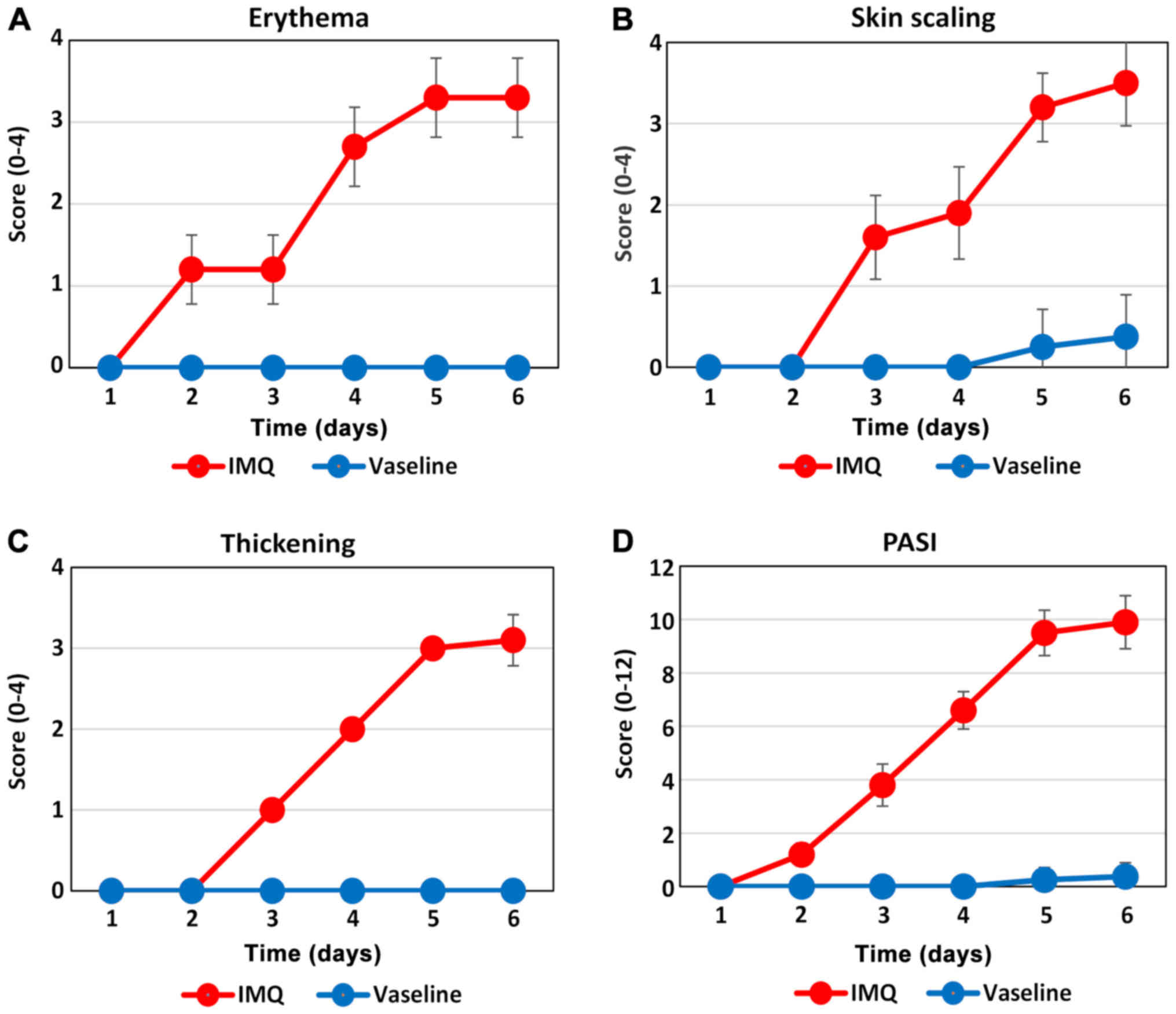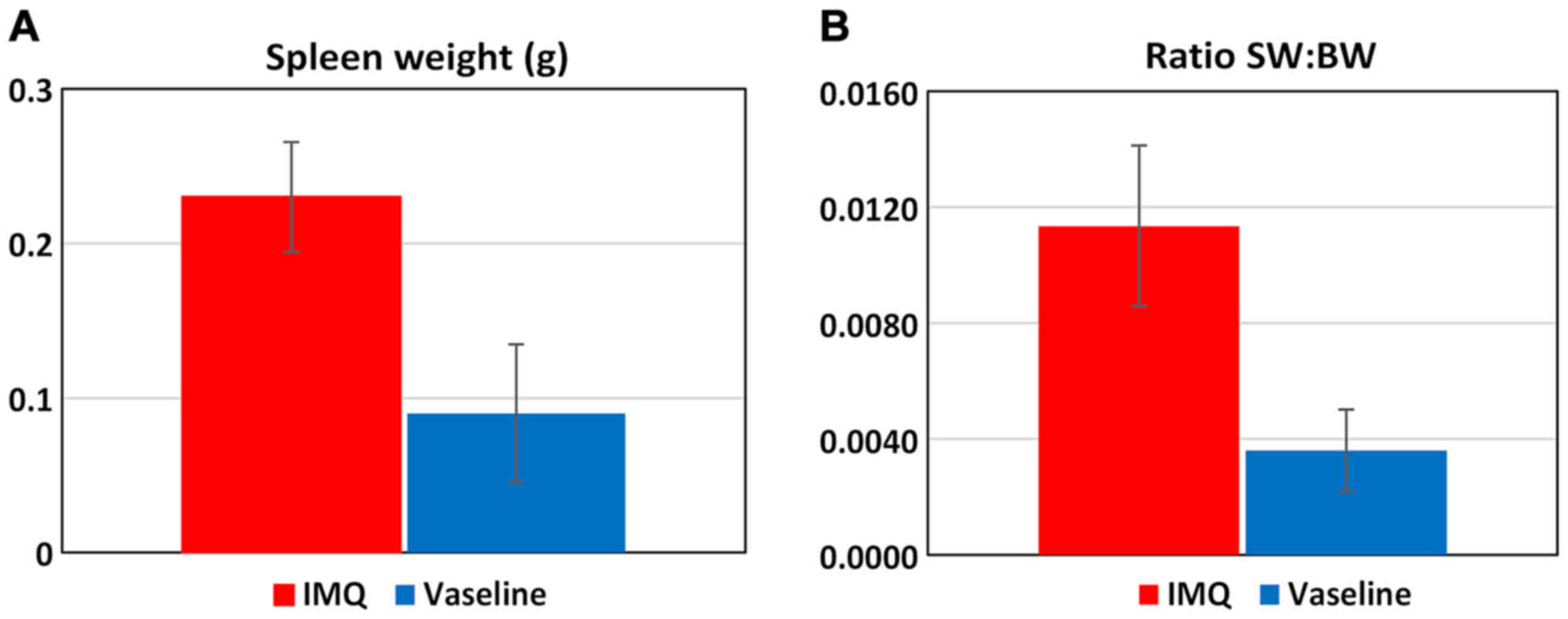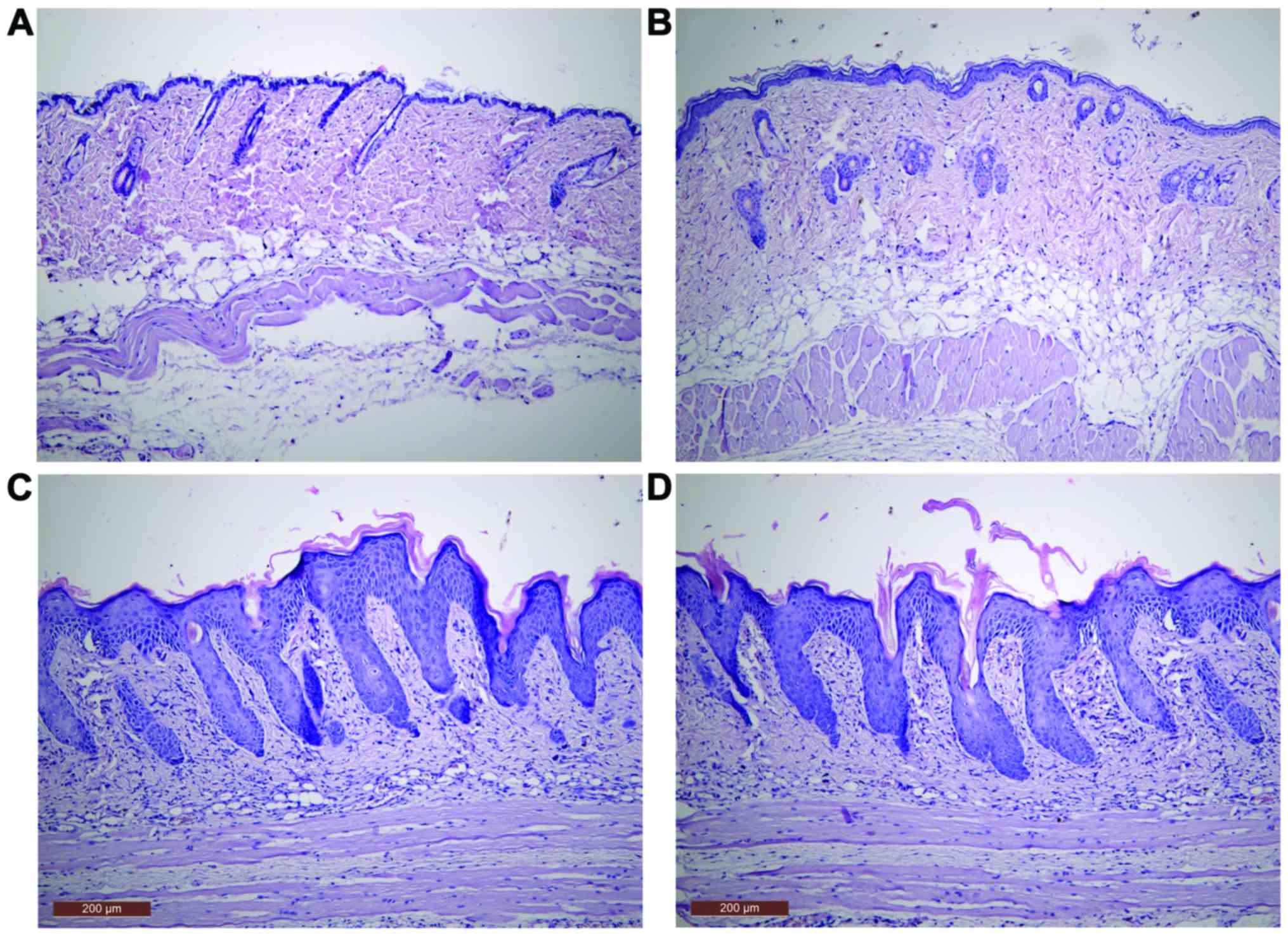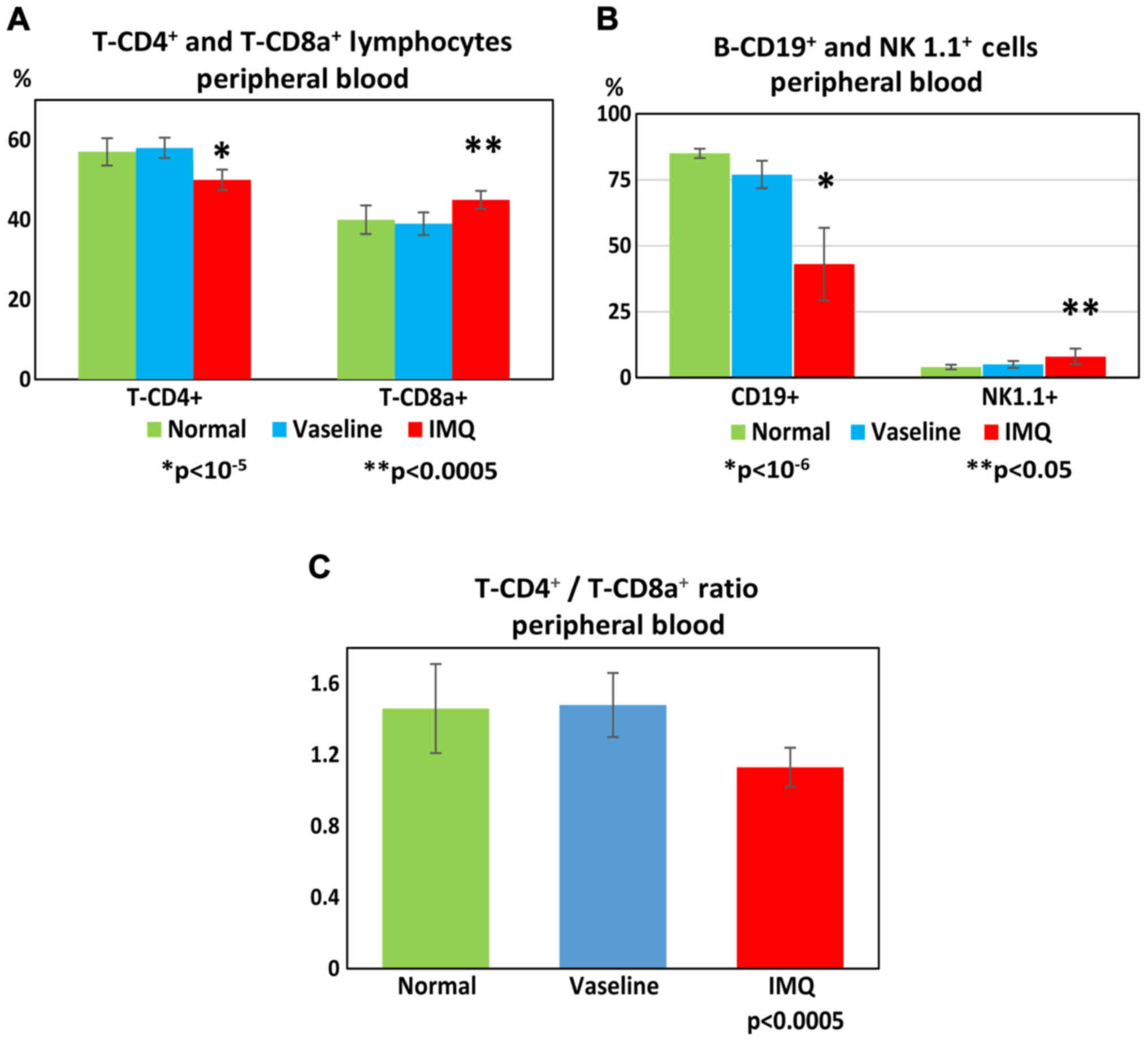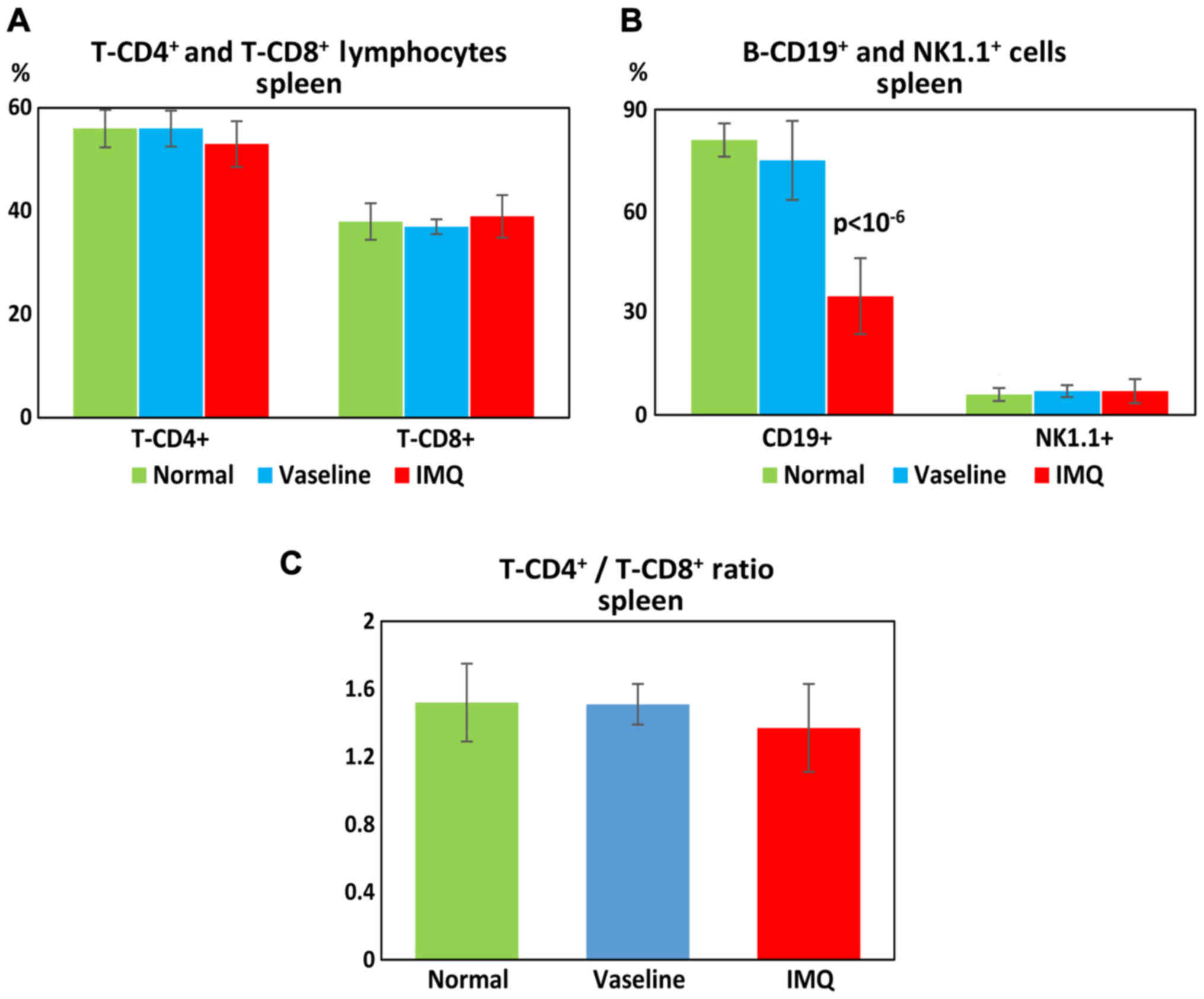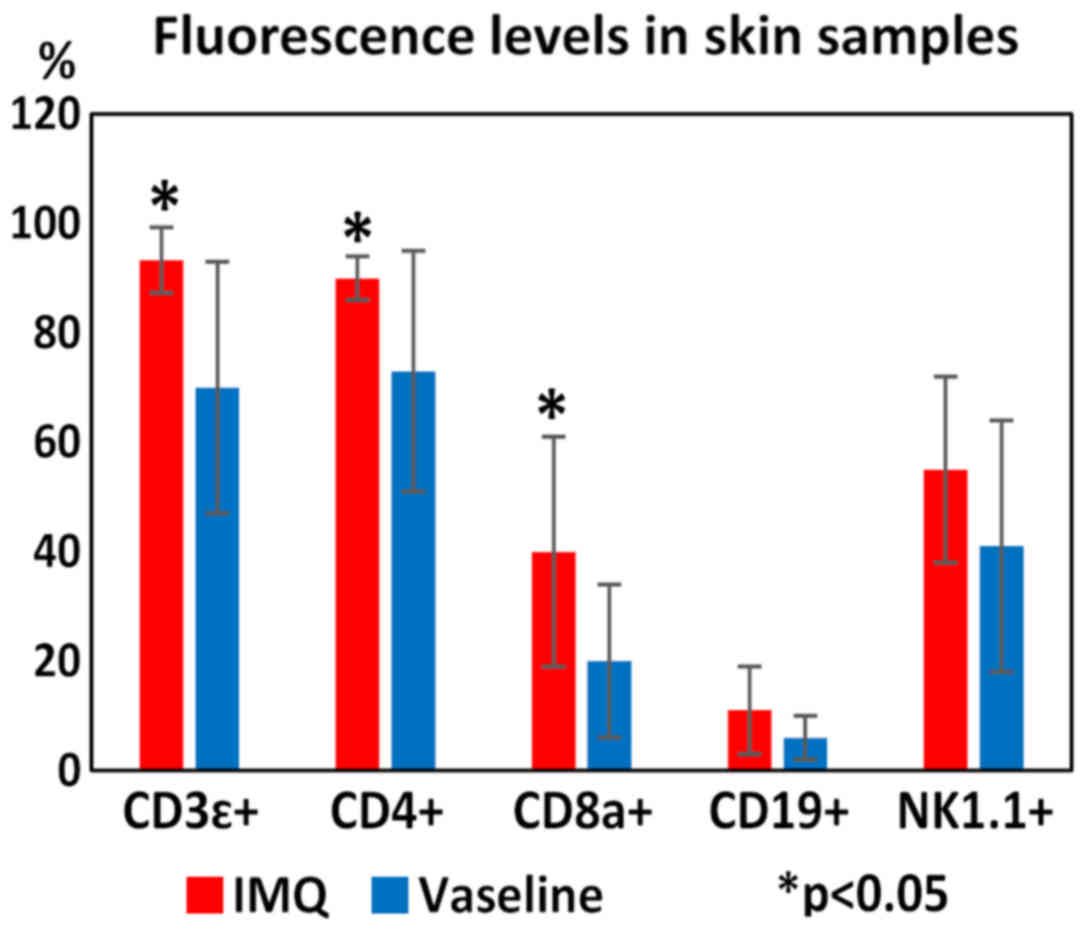|
1
|
Gudjonsson JE, Ding J, Li X, Nair RP,
Tejasvi T, Qin ZS, Ghosh D, Aphale A, Gumucio DL, Voorhees JJ, et
al: Global gene expression analysis reveals evidence for decreased
lipid biosynthesis and increased innate immunity in uninvolved
psoriatic skin. J Invest Dermatol. 129:2795–2804. 2009. View Article : Google Scholar : PubMed/NCBI
|
|
2
|
Parisi R, Symmons DP, Griffiths CE and
Ashcroft DM: Identification and Management of Psoriasis and
Associated ComorbidiTy (IMPACT) project team: Global epidemiology
of psoriasis: A systematic review of incidence and prevalence. J
Invest Dermatol. 133:377–385. 2013. View Article : Google Scholar : PubMed/NCBI
|
|
3
|
Horn EJ, Fox KM, Patel V, Chiou CF, Dann F
and Lebwohl M: Association of patient-reported psoriasis severity
with income and employment. J Am Acad Dermatol. 57:963–971. 2007.
View Article : Google Scholar : PubMed/NCBI
|
|
4
|
Mease PJ and Armstrong AW: Managing
patients with psoriatic disease: The diagnosis and pharmacologic
treatment of psoriatic arthritis in patients with psoriasis. Drugs.
74:423–441. 2014. View Article : Google Scholar : PubMed/NCBI
|
|
5
|
Dommasch ED, Li T, Okereke OI, Li Y,
Qureshi AA and Cho E: Risk of depression in women with psoriasis: A
cohort study. Br J Dermatol. 173:975–980. 2015. View Article : Google Scholar : PubMed/NCBI
|
|
6
|
Ferreira BI, Abreu JL, Reis JP and
Figueiredo AM: Psoriasis and associated psychiatric disorders: A
systematic review on etiopathogenesis and clinical correlation. J
Clin Aesthet Dermatol. 9:36–43. 2016.PubMed/NCBI
|
|
7
|
Kölliker Frers RA, Bisoendial RJ, Montoya
SF, Kerzkerg E, Castilla R, Tak PP, Milei J and Capani F: Psoriasis
and cardiovascular risk: Immune-mediated crosstalk between
metabolic, vascular and autoimmune inflammation. IJC Metab Endocr.
6:43–54. 2015. View Article : Google Scholar
|
|
8
|
Armstrong AW, Harskamp CT and Armstrong
EJ: The association between psoriasis and obesity: A systematic
review and meta-analysis of observational studies. Nutr Diabetes.
2:e542012. View Article : Google Scholar : PubMed/NCBI
|
|
9
|
Ganguly S, Ray L, Kuruvila S, Nanda SK and
Ravichandran K: Lipid accumulation product index as visceral
obesity indicator in psoriasis: A case-control study. Indian J
Dermatol. 63:136–140. 2018.PubMed/NCBI
|
|
10
|
Cohen AD, Dreiher J, Shapiro Y, Vidavsky
L, Vardy DA, Davidovici B and Meyerovitch J: Psoriasis and
diabetes: A population-based cross-sectional study. J Eur Acad
Dermatol Venereol. 22:585–589. 2008. View Article : Google Scholar : PubMed/NCBI
|
|
11
|
Ahlehoff O, Gislason GH, Lindhardsen J,
Charlot MG, Jørgensen CH, Olesen JB, Bretler DM, Skov L,
Torp-Pedersen C and Hansen PR: Psoriasis carries an increased risk
of venous thromboembolism: A Danish nationwide cohort study. PLoS
One. 6:e181252011. View Article : Google Scholar : PubMed/NCBI
|
|
12
|
Ayala-Fontánez N, Soler DC and McCormick
TS: Current knowledge on psoriasis and autoimmune diseases.
Psoriasis (Auckl). 6:7–32. 2016.PubMed/NCBI
|
|
13
|
Sarac G, Koca TT and Baglan T: A brief
summary of clinical types of psoriasis. North Clin Istanb. 3:79–82.
2016.PubMed/NCBI
|
|
14
|
Langley RG and Ellis CN: Evaluating
psoriasis with psoriasis area and severity index, psoriasis global
assessment, and lattice system physician's global assessment. J Am
Acad Dermatol. 51:563–569. 2004. View Article : Google Scholar : PubMed/NCBI
|
|
15
|
Finlay AY and Khan GK: Dermatology Life
Quality Index (DLQI) - a simple practical measure for routine
clinical use. Clin Exp Dermatol. 19:210–216. 1994. View Article : Google Scholar : PubMed/NCBI
|
|
16
|
Mrowietz U and Reich K: Psoriasi - new
insights into pathogenesis and treatment. Dtsch Arztebl Int.
106:11–19. 2009.PubMed/NCBI
|
|
17
|
Caruntu C, Boda D, Dumitrascu G,
Constantin C and Neagu M: Proteomics focusing on immune markers in
psoriatic arthritis. Biomarkers Med. 9:513–528. 2015. View Article : Google Scholar
|
|
18
|
Lande R, Botti E, Jandus C, Dojcinovic D,
Fanelli G, Conrad C, Chamilos G, Feldmeyer L, Marinari B, Chon S,
et al: The antimicrobial peptide LL37 is a T-cell autoantigen in
psoriasis. Nat Commun. 5:56212014. View Article : Google Scholar : PubMed/NCBI
|
|
19
|
Krueger JG: An autoimmune ‘attack’ on
melanocytes triggers psoriasis and cellular hyperplasia. J Exp Med.
212:2186. 2015. View Article : Google Scholar : PubMed/NCBI
|
|
20
|
Benson JM, Sachs CW, Treacy G, Zhou H,
Pendley CE, Brodmerkel CM, Shankar G and Mascelli MA: Therapeutic
targeting of the IL-12/23 pathways: Generation and characterization
of ustekinumab. Nat Biotechnol. 29:615–624. 2011. View Article : Google Scholar : PubMed/NCBI
|
|
21
|
Raţiu MP, Purcărea I, Popa F, Purcărea VL,
Purcărea TV, Lupuleasa D and Boda D: Escaping the economic turn
down through performing employees, creative leaders and growth
driver capabilities in the Romanian pharmaceutical industry.
Farmacia. 59:119–130. 2011.
|
|
22
|
Negrei C, Caruntu C, Ginghina O,
Dragomiroiu GT, Toderescu CD and Boda D: Qualitative and
quantitative determination of methotrexate polyglutamates in
erythrocytes by high performance liquid chromatography. Rev Chim.
66:607–610. 2015.
|
|
23
|
Boda D, Negrei C, Nicolescu F and Balalau
C: Assessment of some oxidative stress parameters in methotrexate
treated psoriasis patients. Farmacia. 62:704–710. 2014.
|
|
24
|
Negrei C, Arsene AL, Toderescu CD, Boda D
and Ilie M: Acitretin treatment in oisturiz may influence the cell
membrane fluidity. Farmacia. 60:767–771. 2012.
|
|
25
|
Negrei C, Ginghină O, Căruntu C, Burcea
Dragomiroiu GT, Jinescu G and Boda D: Investigation relevance of
methotrexate polyglutamates in biological systems by high
performance liquid chromatography. Rev Chim. 66:766–768. 2015.
|
|
26
|
Olteanu R, Constantin MM, Zota A,
Dorobantu DM, Constantin T, Serban ED, Balanescu P, Mihele D and
Gheuca-Solovastru L: Original clinical experience and approach to
treatment study with interleukine 12/23 inhibitor in
moderate-to-severe psoriasis patients. Farmacia. 64:918–992.
2016.
|
|
27
|
Carrascosa JM, Jacobs I, Petersel D and
Strohal R: Biosimilar drugs for psoriasis: Principles, present, and
near future. Dermatol Ther (Heidelb). 8:173–194. 2018. View Article : Google Scholar : PubMed/NCBI
|
|
28
|
Olteanu R, Zota A and Constantin M:
Biosimilars: An update on clinical trials (review of published and
ongoing studies). Acta Dermatovenerol Croat. 25:57–66.
2017.PubMed/NCBI
|
|
29
|
Schön MP and Schön M: Imiquimod: Mode of
action. Br J Dermatol. 157 Suppl 2:8–13. 2007. View Article : Google Scholar : PubMed/NCBI
|
|
30
|
Hemmi H, Kaisho T, Takeuchi O, Sato S,
Sanjo H, Hoshino K, Horiuchi T, Tomizawa H, Takeda K and Akira S:
Small anti-viral compounds activate immune cells via the TLR7
MyD88-dependent signaling pathway. Nat Immunol. 3:196–200. 2002.
View Article : Google Scholar : PubMed/NCBI
|
|
31
|
Urosevic M, Maier T, Benninghoff B, Slade
H, Burg G and Dummer R: Mechanisms underlying imiquimod-induced
regression of basal cell carcinoma in vivo. Arch Dermatol.
139:1325–1332. 2003. View Article : Google Scholar : PubMed/NCBI
|
|
32
|
Kono T, Kondo S, Pastore S, Shivji GM,
Tomai MA, McKenzie RC and Sauder DN: Effects of a novel topical
immunomodulator, imiquimod, on keratinocyte cytokine gene
expression. Lymphokine Cytokine Res. 13:71–76. 1994.PubMed/NCBI
|
|
33
|
Frotscher B, Anton K and Worm M:
Inhibition of IgE production by the imidazoquinoline resiquimod in
nonallergic and allergic donors. J Invest Dermatol. 119:1059–1064.
2002. View Article : Google Scholar : PubMed/NCBI
|
|
34
|
Council NR: Guide for the Care and Use of
Laboratory Animals. 8th. National Academies Press; Washington, DC:
pp. 1–133. 2010
|
|
35
|
van der Fits L, Mourits S, Voerman JS,
Kant M, Boon L, Laman JD, Cornelissen F, Mus AM, Florencia E, Prens
EP, et al: Imiquimod-induced psoriasis-like skin inflammation in
mice is mediated via the IL-23/IL-17 axis. J Immunol.
182:5836–5845. 2009. View Article : Google Scholar : PubMed/NCBI
|
|
36
|
Batani A, Brănișteanu DE, Ilie MA, Boda D,
Ianosi S, Ianosi G and Caruntu C: Assessment of dermal papillary
and microvascular parameters in psoriasis vulgaris using in vivo
reflectance confocal microscopy. Exp Ther Med. 15:1241–1246.
2018.PubMed/NCBI
|
|
37
|
Căruntu C, Boda D, Căruntu A, Rotaru M,
Baderca F and Zurac S: In vivo imaging techniques for psoriatic
lesions. Rom J Morphol Embryol. 55 Suppl 3:1191–1196.
2014.PubMed/NCBI
|
|
38
|
Căruntu C, Boda D, Musat S, Căruntu A and
Mandache E: Stress-induced mast cell activation in glabrous and
hairy skin. Mediators Inflamm. 2014:1059502014. View Article : Google Scholar : PubMed/NCBI
|
|
39
|
Yamamoto T, Matsuuchi M, Katayama I and
Nishioka K: Repeated subcutaneous injection of staphylococcal
enterotoxin B-stimulated lymphocytes retains epidermal thickness of
psoriatic skin-graft onto severe combined immunodeficient mice. J
Dermatol Sci. 17:8–14. 1998. View Article : Google Scholar : PubMed/NCBI
|
|
40
|
Boehncke WH, Zollner TM, Dressel D and
Kaufmann R: Induction of psoriasiform inflammation by a bacterial
superantigen in the SCID-hu xenogeneic transplantation model. J
Cutan Pathol. 24:1–7. 1997. View Article : Google Scholar : PubMed/NCBI
|
|
41
|
Wohn CT, Pantelyushin S, Ober-Blöbaum JL
and Clausen BE: Aldara-induced psoriasis-like skin inflammation:
Isolation and characterization of cutaneous dendritic cells and
innate lymphocytes. Methods Mol Biol. 1193:171–185. 2014.
View Article : Google Scholar : PubMed/NCBI
|
|
42
|
Lundberg KC, Fritz Y, Johnston A, Foster
AM, Baliwag J, Gudjonsson JE, Schlatzer D, Gokulrangan G, McCormick
TS, Chance MR, et al: Proteomics of skin proteins in psoriasis:
From discovery and verification in a mouse model to confirmation in
humans. Mol Cell Proteomics. 14:109–119. 2015. View Article : Google Scholar : PubMed/NCBI
|
|
43
|
Neagu M, Constantin C and Zurac S: Immune
parameters in the prognosis and therapy monitoring of cutaneous
melanoma patients: Experience, role, and limitations. Biomed Res
Int. 2013:1079402013. View Article : Google Scholar : PubMed/NCBI
|
|
44
|
Manda G, Neagu M, Livescu A, Constantin C,
Codreanu C and Radulescu A: Imbalance of peripheral B lymphocytes
and NK cells in rheumatoid arthritis. J Cell Mol Med. 7:79–88.
2003. View Article : Google Scholar : PubMed/NCBI
|
|
45
|
Singh K, Gatzka M, Peters T, Borkner L,
Hainzl A, Wang H, Sindrilaru A and Scharffetter-Kochanek K: Reduced
CD18 levels drive regulatory T cell conversion into Th17 cells in
the CD18hypo PL/J mouse model of psoriasis. J Immunol.
190:2544–2553. 2013. View Article : Google Scholar : PubMed/NCBI
|
|
46
|
Prinz I and Sandrock I: γδ T cells come to
stay: Innate skin memory in the Aldara model. Eur J Immunol.
45:2994–2997. 2015. View Article : Google Scholar : PubMed/NCBI
|



